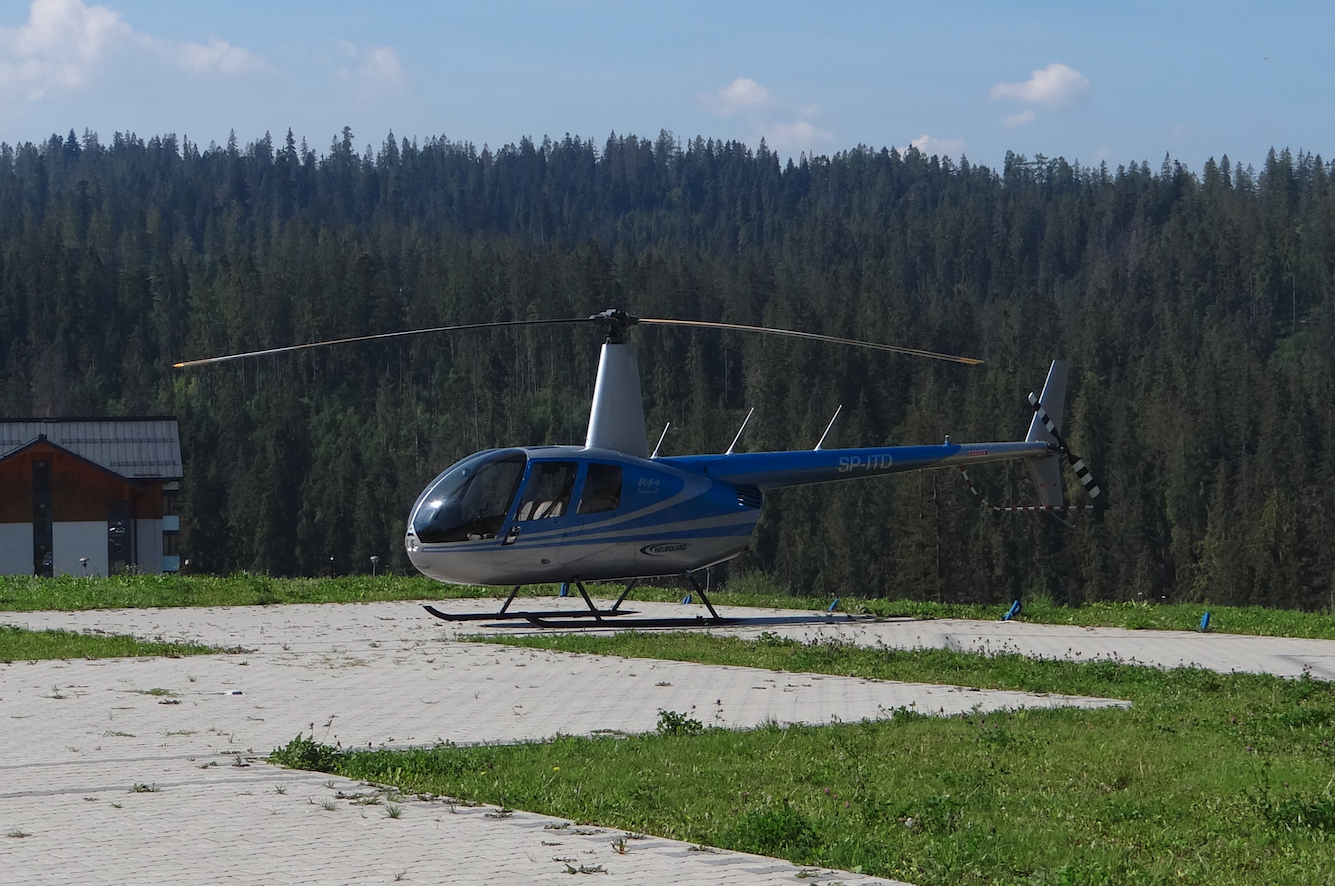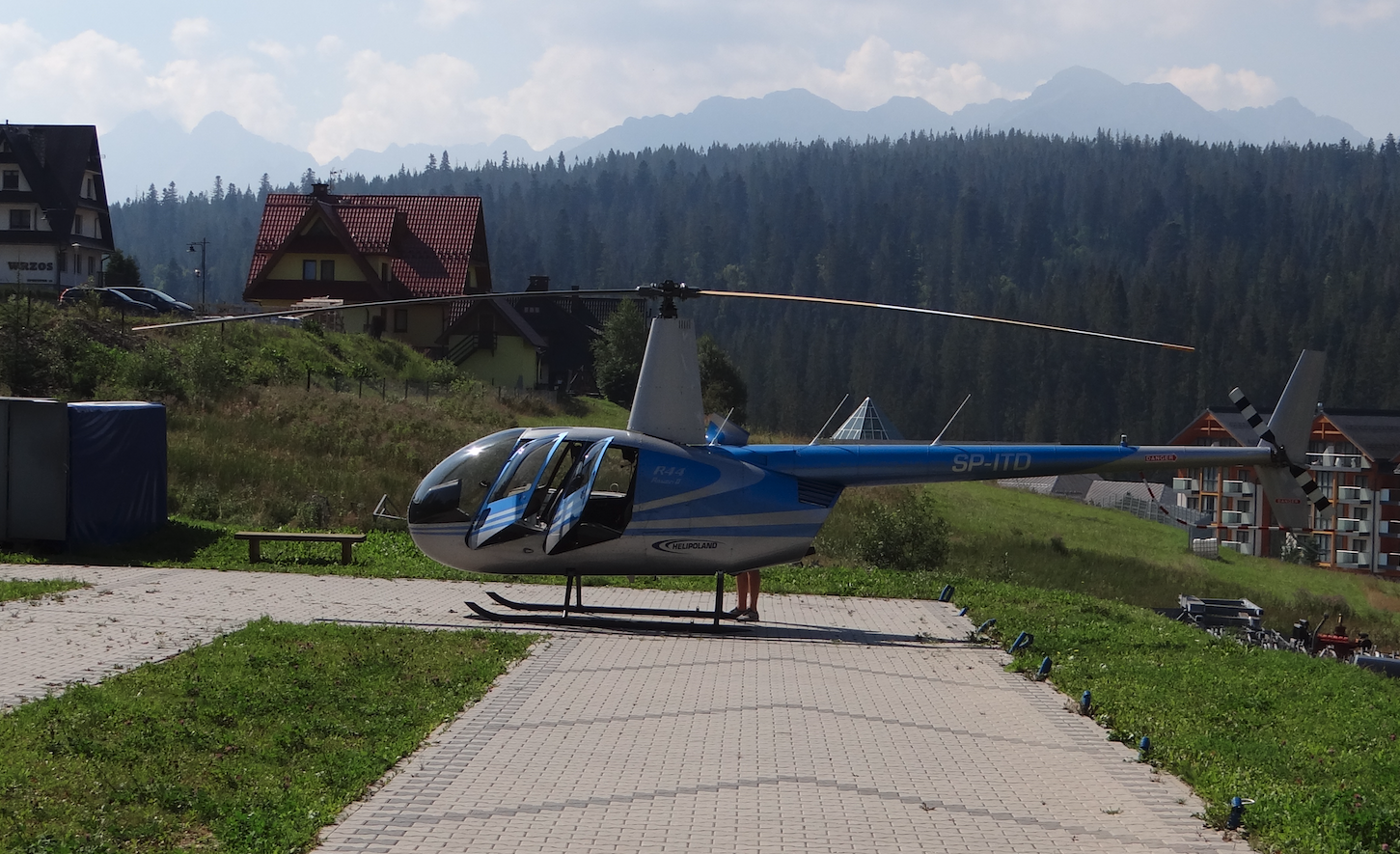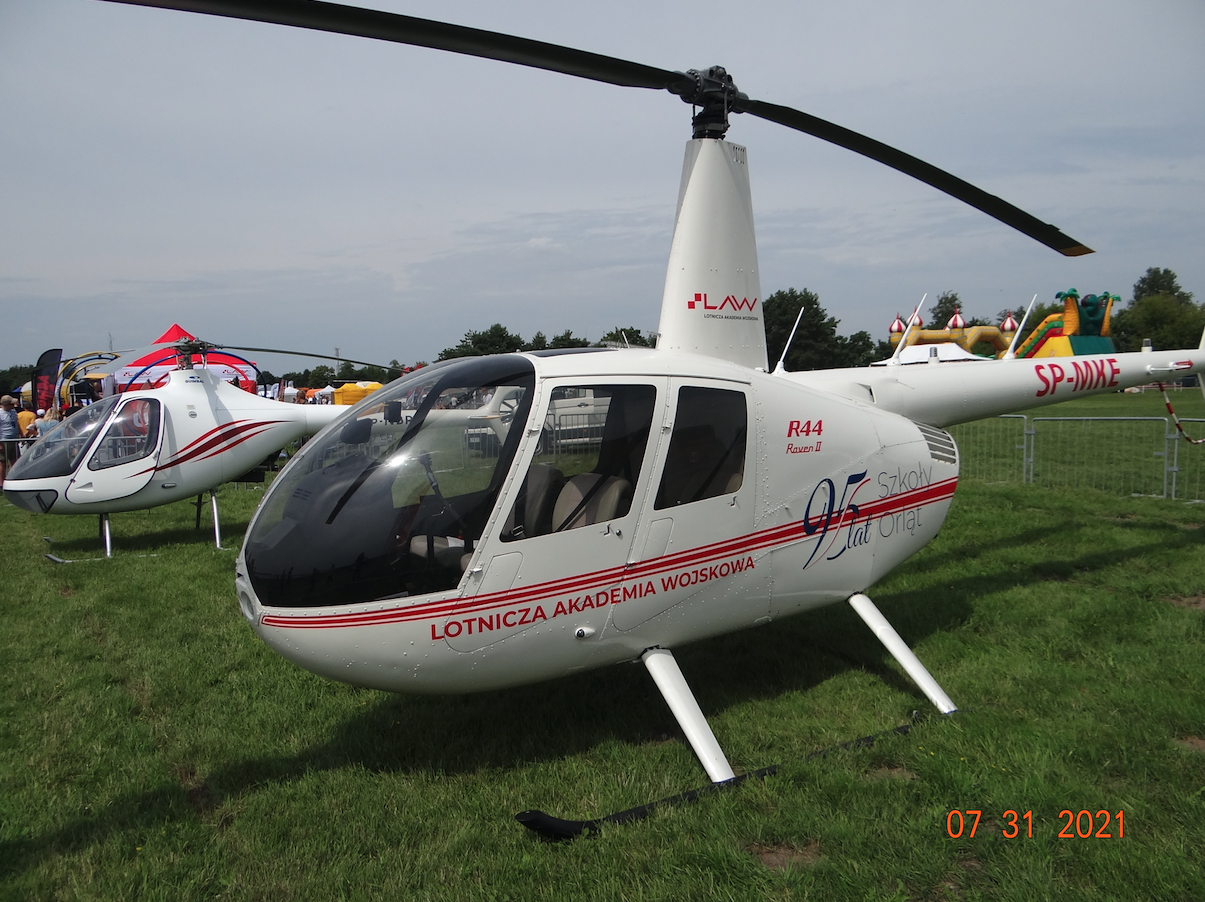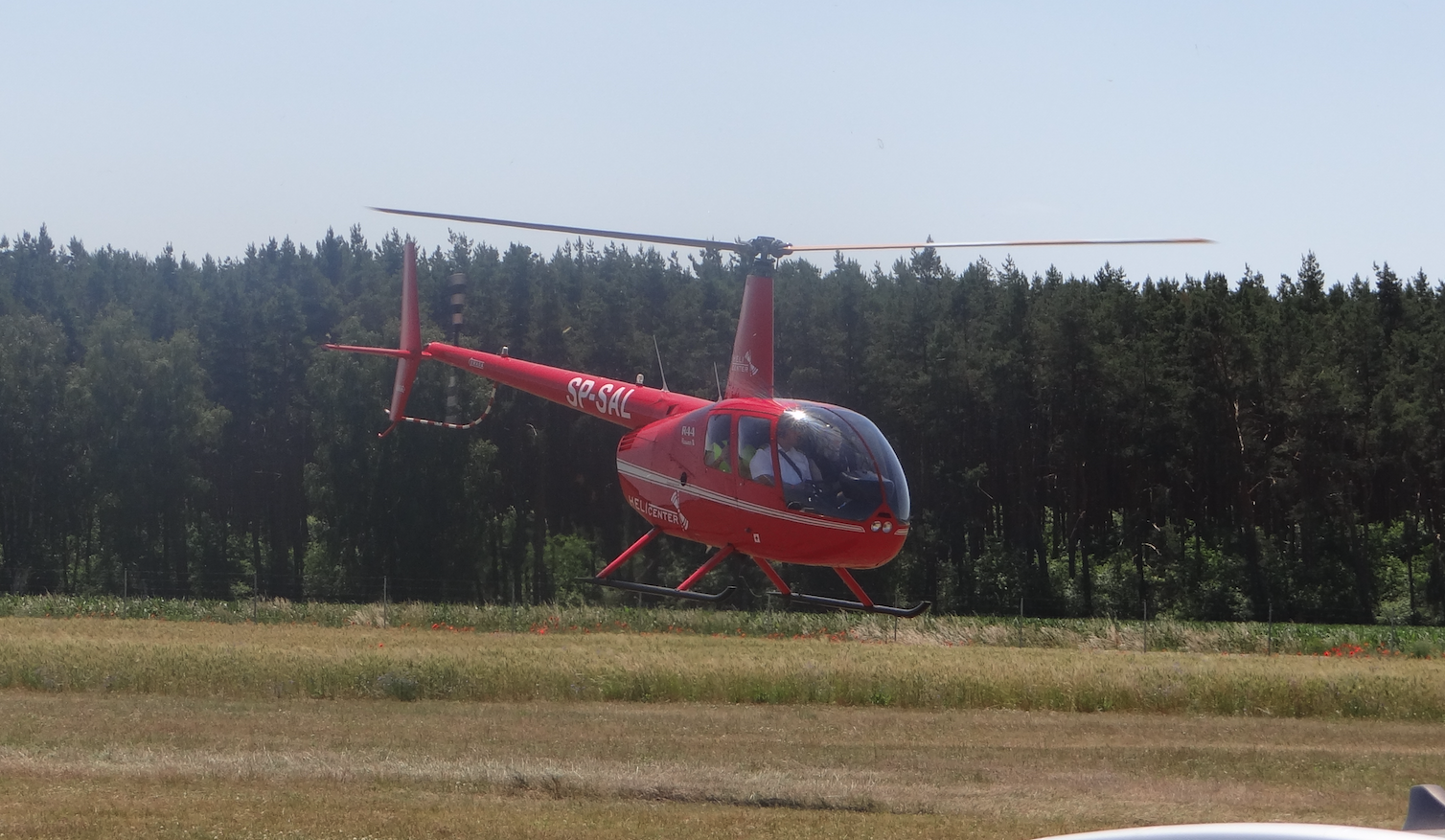Kraków 2022-08-23
Light Robinson R44 helicopter.




Before we discuss the Robinson R44 helicopter, we must go back to its ancestor, the Robinson R22 helicopter.
Robinson R22.
The Robinson R22 light helicopter was developed in the United States of America in 1973 by engineer Frank D. Robinson. The idea was to make a cheap light helicopter accessible to everyone. Therefore, a Textron Lycoming O-320-B2C internal combustion piston engine with 160 hp (118 kW) was used for the drive. The helicopter received a cabin designed for two people; pilot and passenger.
The first flight of the Robinson R22 helicopter was made on August 28, 1975. The R22 helicopter was certified by the Federal Aviation Administration in March 1979. Serial production started in April 1979 and by 2015 more than 4,600 units were produced. The production was carried out by the Robinson Helicopter Company. In 2019, the Robinson R22 helicopter was in mass production.
Due to the relatively low purchase and operating costs, the R22 helicopter is popular all over the world. Mainly as a school and training helicopter. The helicopter is suitable for reconnaissance, control of power lines and pipelines, and liaison flights. In the USA, the helicopter is also used by cattle breeders.
The main rotor has two blades. The main rotor is controlled by mechanical pushers, without hydraulic support. This control system is very sensitive, but pilots who have mastered the R22 are well prepared for training on larger helicopters. The rotor has high inertia and an additional friction brake is used to stop it.
The basic structure of the airframe is based on pipes made of chromium-molybdenum steel, joined by welding. The front of the fuselage is made of fiberglass and aluminum, and the windows are made of plexiglass. The tail boom as well as the vertical and horizontal stabilizers are made of aluminum. The R22 has a closed cabin with side-by-side seats for the pilot and passenger.
The helicopter has a two-skid undercarriage. There is no wheeled version. A trolley is used to move the helicopter. There is a version of the helicopter equipped with floats.
A unique "T-Bar" control stick was used in the helicopter. The main stick comes from the center console, not from the floor between your legs. The stick is available for the remote control on the left or right side. When the other person does not have the pilot's license, the handle of the stick on his side is dismantled. This solution makes it easier for pilots and passengers to board the helicopter. The R22 helicopter has a voice activated intercom. Older models had a foot-operated switch in the floor.
Lycoming.
Lycoming O-320 or Lycoming O-360 engine, 4 cylinder, fan air cooled, carburettor. The engine is mounted flat. The engine runs on 100LL aviation gasoline. An automatic speed governor is used in newer engines. The engine is not supercharged. Power from the engine is transferred to the drive system via drive belts. Originally there were four separate V-belts. But as a result of the accumulated experience, two double V-belts were used. A belt tensioning actuator is used to disconnect the motor from the drive shaft. During start-up, the engine is started with loose belts, which allows the engine to run without turning the rotor system. A one-way spring clutch is built into the center of the top pulley to allow the rotor system to continue spinning in the event of an engine failure, allowing the R22 to auto-rotate and land in a controlled manner.
Data T-T Robinson R22:
Length 28 ft 8 in (8.74 m). Height 8 ft 11 in (2.72 m). Rotor diameter 25 ft 2 in (7.67 m). Tail rotor diameter 3 ft 6 in (1.1 m). Curb weight 880 lb (399 kg). Take-off weight 1,370 lb (621 kg). Top speed 190 km / h. Service ceiling 14,000 ft (4,300 m). Maximum range 209 nm (241 mi.387 km). Fuel supply 16.9 US gal (14 imp gal; 64 l).
Robinson R44.
The success of the Robinson R22 helicopter meant that the Robinson Helicopter Company decided to build a larger helicopter for 4 people. He made his first R44 flight on March 31, 1990. The helicopter was certified by the FAA in December 1992. Serial production started in 1993. The R44 helicopter has been the world's best-selling General Aviation (GA) helicopter since 1999. The R44 helicopter in the period 2001 - 2020 was built in the number of 5,941 copies.
The R44 helicopter is powered by a Lycoming IO-540-AE1A5, 6-cylinder, opposing cylinder engine, 183 kW.
The R44 helicopter is based on the design of the R22 helicopter. One of the interesting facts is that the direction of the rear rotor movement has been changed from the R22 to improve its yaw control.
Several modifications were made during production. In July 2002, the Robinson Raven II helicopter was introduced, which offers a more advanced fuel-injected engine and wider rotor blades, allowing for increased overall weight and ceiling.
The Robinson Helicopter Company also developed the R66 helicopter, which is powered by a turbine engine. The helicopter takes 5 people on board.
Construction Robinson R44.
The Robinson R44 is a four-seater light helicopter manufactured by the Robinson Helicopter Company since 1993. Based on the company's two-seater Robinson R22. The R44 helicopter is equipped with a hydraulic assisted flight control. The R44 helicopter is a single-engine helicopter with a semi-rigid two-blade main rotor, a two-blade tail rotor and a skid undercarriage. The machine has a closed cabin with two rows of seats next to each other for the pilot and three passengers. In July 2002, Robinson unveiled the R44 Raven II, featuring a more powerful fuel-injected engine with wider blades, resulting in higher gross weight and improved altitude performance.
Data T-T Robinson R44:
Main rotor diameter 33 ft (10 m). Length 38 ft 3 in (11.66 m). Height 10 ft 9 in (3.28 m). Tail rotor diameter 3 ft 6 in (1.1 m). Curb weight 1.505 lb (683 kg). Take-off weight 2,500 lb (1,134 kg). Maximum speed of 130 kn (150 mph, 240 km / h). Cruising speed 109 kn (125 mph, 202 km / h). Service ceiling of 14,000 ft (4,300 m). Maximum range 300 nm (350 mi, 560 km). Fuel supply 31.6 US gal (26 imp gal; 120 l). Paliwo 100 octane low lead (100LL) fuel or 100/130 octane. Fuel consumption 15 gallons per hour (12 imp gal / h; 57 l / h. Engine Lycoming IO-540-AE1A5 6-cylinder air-cooled horizontally-opposed piston engine, 245 hp (183 kW).
Robinson R44 in Poland.
On July 9, 2018, the Air Force Academy in Dęblin signed an agreement for the purchase of two R44 helicopters for an academic school with JB Investments. Both purchased machines were delivered to Dęblin on November 14, 2018.
Robinson R44 helicopters were also selected on July 31, 2018 by the Polish Medical Air Rescue in a tender for the delivery of two training and training helicopters.
The Border Guard received the first R44 helicopter.
On April 11, 2019, the R44 helicopter was picked up by the Border Guard. The machine is used, inter alia, for the training of flying personnel and training, and above all for state border control. There was talk of the purchase of a new helicopter for the Border Guard in mid-2018. The Ministry of Interior and Administration has announced a tender for the purchase of a multipurpose helicopter with at least 4 seats, which is to be used by the Border Guard aviation for operational (patrol and reconnaissance) and operational flights over the land area. The price for one R44 helicopter was PLN 3,175,000. The tender was settled on November 16, 2018.
The Robinson R44 Raven II helicopter for the Border Guard has a modern digital avionics (glass cockpit), a double control system and a four-seater cabin. The drive is a six-cylinder Lycoming IO-540-AE1A5 engine, with a take-off power of 245 HP, which allows it to reach a speed of 234 km / h and a range of about 560 km without additional tanks that can be placed under the passenger seats.
On April 11, 2019 (Thursday), Deputy Prime Minister Beata Szydło, Joachim Brudziński, the Minister of Interior and Administration handed over the first R44 helicopter to the Border Guard. The Chaplain of the Border Guard blessed the new machine. The event took place at the Air Base at 188 Węgierska Street in Nowy Sącz. In 2019, the Border Guard was enriched with an Airbus Helicopters H135 helicopter worth over PLN 46 million, in 2020 two Let Aircraft Industries L 410 UVP E-20 planes were delivered to the Border Guard.
Written by Karol Placha Hetman
